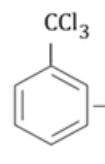Complete Solutions to CHEMISTRY of chapter NTA JEE MOCK TEST 58 of Class 12 book with complete answers and questions
| Class 12 | CHEMISTRY |
| Chapter | NTA JEE MOCK TEST 58 |
| NTA MOCK TEST | CHEMISTRY |
| Number Of Questions | 25 |
| Academic Year | 2023-24 |
The correct bond order in the following species is:
View SolutionWhich of the following is the strongest reducing agent in aqueous medium?
View SolutionWhat will be the relation between the `T_(1)` of gas 1 with `M_(1)=56` and `T_(2)` of gas 2 with `M_(2)=44` if the average speed of gas 1 is equal to most probable speed of gas 2?
View SolutionConsider the following reaction :
`xMnO_(4)^(-)+yC_(2)O_(4)^(2-)+zH^(+) to xMn^(2+)+2yCO_(2)+(z)/(2)H_(2)O`
The value of x, y and z in the reaction are, respectively.
View SolutionWhat will be the correct decreasing order of acid strength of the hydroxybenzoic acids? (Symbols and notations carry their usual meanings)
View SolutionThe specific rotation of a pure enantiomer is `+10^(@)`. The observed rotation, if it is isolated from a reaction with `30%` recemisation and `70%` inversion is
View SolutionA certain reaction occurs in two steps as
(I) `2SO_(2(g))+2NO_(2(g)) to 2SO_(3(g))+2NO_((g))`
`(ii) 2NO_((g) ) +O_(2) (g) to 2NO_(2(g))`
In the reaction ,______.
View SolutionAn ideal gas is expand from `(P_(1),V_(1),T_(1))` to `(P_(2),V_(2),T_(2))` under different conditions. The correct statement(s) among the following is (are):
View SolutionWhich of the following electrolytes will have maximum coagulating value for `Ag//Ag^(+)` sol?
View SolutionThe possible product obtained from the reaction of cyclobutyl amine with `HNO_(2)` followed by treating with water is
View SolutionConsider the reaction equilibrium, `2SO_(2(g)) + O_(2(g))hArr SO_3 (g), Delta H^(@) = - 198 kJ` . On the basis of Le-Chatelier's principle, the condition favourable for the forward reaction is
View SolutionThe correct order of reactivity for the addition reaction of the following carbonly compounds with ethyl magnesium iodide is

View SolutionFor the reaction,
`A+BrarrP,-(d[A])/(dt)=-(d[B])/(dt)=k[A][B] and Rt=(1)/([A_(0)]-[B]_(0))ln.([A][B]_(0))/([B][A]_(0))` when `[A]_(0)ne[B]_(0)`
If `[A]_(0)=[B]_(0)` then the integrated rate law will be
View SolutionWhich of the following cations has the strongest tendency towards complex formation?
View SolutionWhich chemical change among the following involves absorption of heat?
View SolutionWhich of the following curve will represent the variation of conductance C during titration of `CH_(3)COOH` by gradual addition of NaOH solution (V)
View Solution `overset(Ca(OH)_(2)(aq))rarrAoverset(NH_(3)//Delta)underset(Br_(2)+NaOH)rarr Boverset(Br_(2)//H_(2)O)rarr C`
`overset(Ca(OH)_(2)(aq))rarrAoverset(NH_(3)//Delta)underset(Br_(2)+NaOH)rarr Boverset(Br_(2)//H_(2)O)rarr C`
In the above sequence, C is
View SolutionThe electrode potential, `E^(@)`, for the reduction of `MnO_(4)^(-)" to "Mn^(2+)` in acidic medium is `+1.51V`. Which of the following metal(s) will be oxidised? The reduction reactions and standard electrode potentials for `Zn^(2+), Ag^(+) and Au^(+)` are given as
`Zn_((aq))^(2+)+2e^(-)rarrZn_((s)),E^(@)=-0.762V`
`Ag_((aq))^(+)+e^(-)hArr Ag_((x)), E^(@)=+0.80V`
`Au_((aq))^(+)+e^(-)hArr Au_((s)), E^(@)=+1.69V`
View SolutionWhat final product will form when alcoholic KOH is treated with 1, 1- dichloroethane?
View SolutionConsider the following antibiotics
(i) Erythromycin
(ii) Ofloxacin
(iii) Chloramphenicol
(iv) Penicillin
The pair of bactericidal antibodies is
View SolutionHow many statements is/are correct for given complex `[Co(C_(2)O_(4))_(3)]^(3-)`
i) It contain negative ligands only
ii) The oxidation state of central metal atom is `+3`
iii) it is optically active
iv) Due to chelation the stability of the complex increases
v) It exhibit geometrical isomerism
vi) it is octahedral with `d^(2)sp^(3)` hybridization.
vii) All oxalate ligands are replaced by ethylenediamine, then complex do not show optical activity.
View SolutionThe number of alkenes (including stereoisomers) which can produce 2 - butanol by the successive treatment of (i) `B_(2)H_(6)` in tetrahydrofuran solvent and (ii) alkaline `H_(2)O_(2)` solution is/are
View SolutionThe `K_(sp)` of `Mg(OH)_(2)` is `1xx10^(-12)`. `0.01 M Mg(OH)_(2)` will precipitate at the limiting `pH`
View SolutionAn organic compound A ( mol wt = 180) is acylated with `CH_3 COCl` to get acylated compound of mol wt. 390. What is the number of amino groups present per molecule of the compound A?
View Solution1.5 gm sample of bleaching power was suspended in water. If was treated with `CH_(3)COOH` followed by the addition of excess of Kl. The liberated iodine required 150 mL of `(M)/(10)` hypo solution for complete titration. The percentage of available chlorine in the sample is
View Solution
CHEMISTRY questions and complete solutions for chapter NTA JEE MOCK TEST 58 of NTA MOCK TESTS of Class 12